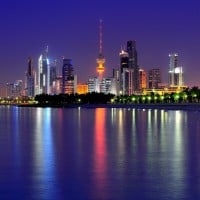Top 10 Places in the World with the Most Unusual Climate Patterns
This list refers to cities, towns or villages (regions inhabited by humans) in the world with unusual climate each year.This small city (according to Chinese standards) of population 630,000 in the elevated Gobi desert has one of the most continental climates in the world; average temperatures in july range between 28°C to 41°C while average temperatures in January ranges from -13°C to -3°C.
Dallol features an extreme version of a hot desert climate, typical of the Danakil Desert. Dallol is the hottest place year-round on the planet and currently holds the record high average temperature for an inhabited location on Earth, with an average annual temperature of 34.6 °C (94.3 °F). The annual average high temperature is 41 °C (105 °F) and the hottest month has an average high of 46.7 °C (116.1 °F). The coolest month, January also features frequent daily maximum temperatures of 40°C. In addition to being extremely hot year-round, the climate of the lowlands of the Danakil Depression is also extremely dry and arid in terms of annual average rainy days as only a few days record measurable precipitation. The hot desert climate of Dallol is particularly due to the extremely low elevation, it being inside the tropics and near the hot Red Sea during winters, the very low seasonality impact, the constants of the extreme heat and the lack of nighttime cooling.
Though this place has comfortable temperatures throughout the year, this region with a population of about 15,000 holds the Guinness world record for the highest average annual rainfall of about 1200 centimetres, which is actually quite high and no other place comes close to this number.
This place isn't exactly "populated"; but it's a tourist place which attracts many visitors which has deep caves formed due to tectonic movements, this place holds the record of the world's most diurnal variation in temperature.
Average temps in January:
Minimum: -3°C
Maximum: 17°C
Average temps in July:
Minimum: 5°C
Maximum: 38°C
It has the highest variation in the daily maximum and minimum temperatures, as we can see in the summer months.
This place lies above the arctic circle (it lies at a latitude of 68.4°) but has a warm climate compared to other regions in the same latitude. Average minimum temperatures in January is 0°C and due to influence of warm ocean currents from the south, temperatures rarely go below -1°C even in January when there sun remains below the horizon. The summers are only slightly less cooler with average highs and lows of 14°C & 10°C in July respectively.
The population in this village is about 3,500.
Most of Northern Norway is very warm for its latitude because the Gulf Stream makes it warmer. Inland Norway is where it's actually cold.

The capital of Kuwait with a population of 4.1 million people is another contender for the title of one of the hottest cities in the world with average highs of over 113 degrees F (45 degrees C) from June to August. Nightfall brings little respite, with after-dark low temperatures often exceeding 90 degrees F (32 degrees C) during the summer months. Kuwait City’s record high is 126 degrees F (52 degrees C), while the winters are cool.
This desert region with a population of about 35,000 has average highs exceeding 39°C throughout March to October, and occasionally in cooler months like January too it can get as hot as 40°C while the nights remain warm. It's unusual for this region to be hot throughout the year, as other parts of the Sahara desert experience only moderate heat in autumn or spring. Timbuktu's proximity to the equator causes it to have year-round sweltering heat.
Though statistically this city with about 4.8 million people has normal-seeming temperatures, Melbourne is well known for its changeable weather conditions. This is mainly due to Melbourne's geographical location. This temperature differential is most pronounced in the spring and summer months and can cause strong cold fronts to form. These cold fronts can be responsible for all sorts of severe weather from gales to severe thunderstorms and hail, minor temperature drops, and heavy rain. As a climatologist once said, "Melbourne doesn't have climate. Only weather."
 Chicago, officially the City of Chicago, is the third-most populous city in the United States. With over 2.7 million residents, it is also the most populous city in both the state of Illinois and the Midwestern United States. Chicago is considered one of the most important business centers in the world... read more
Chicago, officially the City of Chicago, is the third-most populous city in the United States. With over 2.7 million residents, it is also the most populous city in both the state of Illinois and the Midwestern United States. Chicago is considered one of the most important business centers in the world... read more